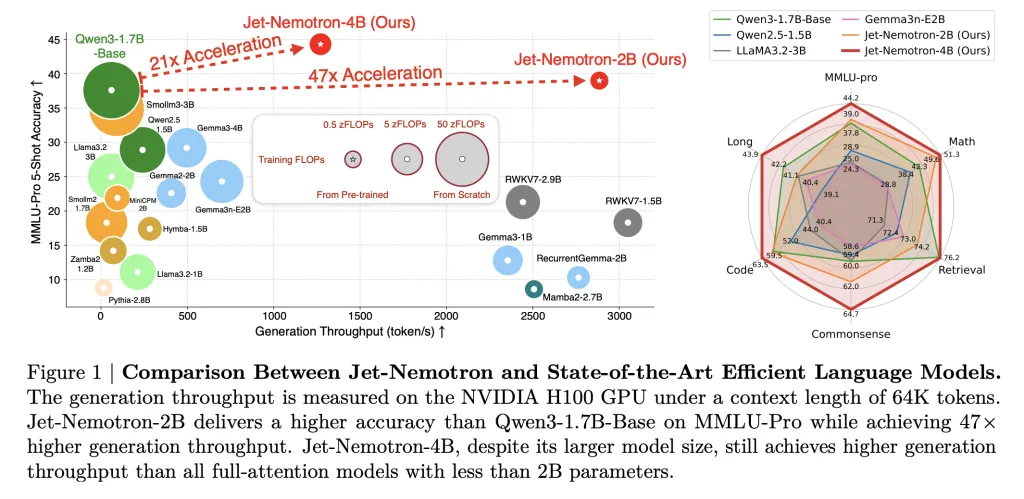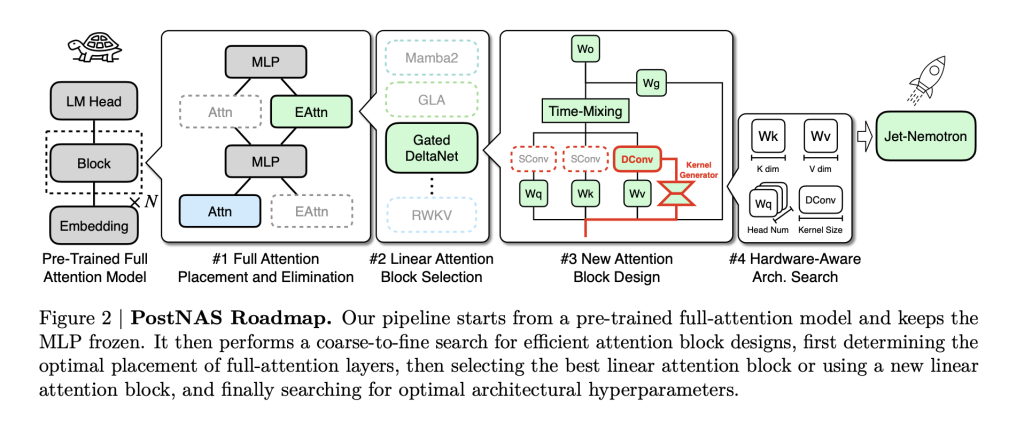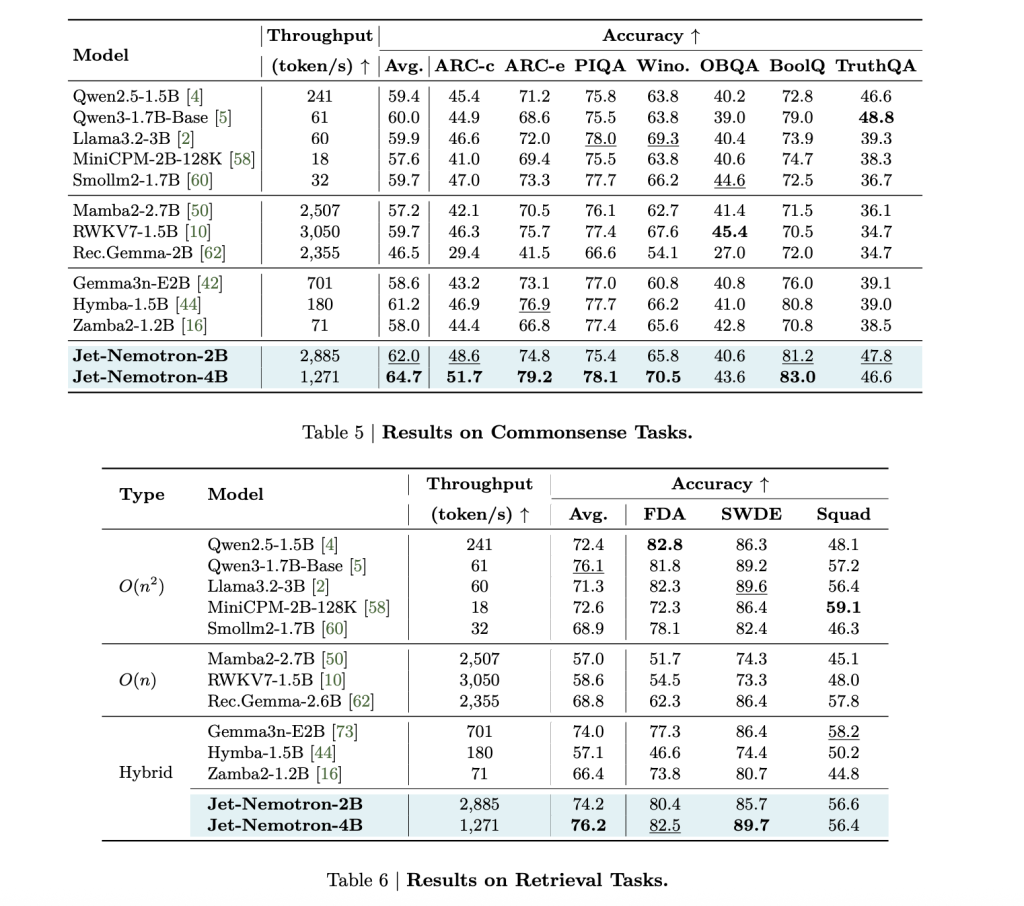NVIDIA researchers have shattered the longstanding efficiency hurdle in large language model (LLM) inference, releasing Jet-Nemotron—a family of models (2B and 4B) that delivers up to 53.6× higher generation throughput than leading full-attention LLMs while matching, or even surpassing, their accuracy. Most importantly, this breakthrough isn’t the result of a new pre-training run from scratch, but rather a retrofit of existing, pre-trained models using a novel technique called Post Neural Architecture Search (PostNAS). The implications are transformative for businesses, practitioners, and researchers alike.
The Need for Speed in Modern LLMs
While today’s state-of-the-art (SOTA) LLMs, like Qwen3, Llama3.2, and Gemma3, have set new benchmarks for accuracy and flexibility, their O(n²) self-attention mechanism incurs exorbitant costs—both in compute and memory—especially for long-context tasks. This makes them expensive to deploy at scale and nearly impossible to run on edge or memory-constrained devices. Efforts to replace full-attention Transformers with more efficient architectures (Mamba2, GLA, RWKV, etc.) have struggled to close the accuracy gap, until now.


PostNAS: A Surgical, Capital-Efficient Overhaul
The core innovation is PostNAS: a neural architecture search pipeline designed specifically for efficiently retrofitting pre-trained models. Here’s how it works:
- Freeze the Knowledge: Start with a SOTA full-attention model (like Qwen2.5). Freeze its MLP layers—this preserves the model’s learned intelligence and greatly reduces training cost.
- Surgical Replacement: Replace computationally expensive full-attention (Transformers) with JetBlock, a new, hardware-efficient linear attention block designed for NVIDIA’s latest GPUs.
- Hybrid, Hardware-Aware Design: Use super-network training and beam search to automatically determine the optimal placement and minimal set of full-attention layers necessary to preserve accuracy on key tasks (retrieval, math, MMLU, coding, etc.). This step is task-specific and hardware-aware: the search maximizes throughput for target hardware, not just parameter count.
- Scale and Deploy: The result is a hybrid-architecture LLM that inherits the backbone intelligence of the original model but slashes latency and memory footprint.
JetBlock is particularly noteworthy: it introduces dynamic causal convolution kernels conditioned on input (unlike static kernels in prior linear attention blocks) and removes redundant convolutions for streamlined efficiency. With hardware-aware hyperparameter search, it not only keeps pace with prior linear attention designs in throughput, but actually boosts accuracy.


Jet-Nemotron: Performance by the Numbers
The key metrics from NVIDIA’s technical paper are staggering:
| Model | MMLU-Pro Acc. | Generation Throughput (tokens/s, H100) | KV Cache Size (MB, 64K context) | Notes |
|---|---|---|---|---|
| Qwen3-1.7B-Base | 37.8 | 61 | 7,168 | Full-attention baseline |
| Jet-Nemotron-2B | 39.0 | 2,885 | 154 | 47× throughput, 47× smaller cache |
| Jet-Nemotron-4B | 44.2 | 1,271 | 258 | 21× throughput, still SOTA acc. |
| Mamba2-2.7B | 8.6 | 2,507 | 80 | All-linear, much lower accuracy |
| RWKV7-1.5B | 13.4 | 3,050 | 24 | All-linear, much lower accuracy |
| DeepSeek-V3-Small (MoE) | — | — | — | 2.2B activated, 15B total, lower acc. |
Jet-Nemotron-2B matches or exceeds Qwen3-1.7B-Base on every major benchmark—math, commonsense, coding, retrieval, long-context—while delivering 47× higher generation throughput.
This isn’t a small gain: a 53.6× speedup in decoding at 256K context length means a 98% reduction in inference cost for the same volume of tokens. Prefilling speedups are also dramatic: 6.14× faster at 256K context.
Memory footprint shrinks by 47× (154MB cache vs. 7,168MB for Qwen3-1.7B-Base). This is a game-changer for edge deployment: Jet-Nemotron-2B is 8.84× and 6.5× faster than Qwen2.5-1.5B on Jetson Orin and RTX 3090, respectively.


Applications
For Business Leaders: Better ROI $$
- Inference at scale is now affordable. A 53× throughput gain means dollar-for-dollar, you can serve 53× more users—or slash hosting costs by 98%.
- Operational efficiency is transformed: latency drops, batch sizes grow, and memory constraints vanish. Cloud providers can offer SOTA AI at commodity prices.
- The AI business model reshapes: Tasks once too expensive (real-time document AI, long-context agents, on-device copilots) suddenly become viable.
For Practitioners: SOTA on the Edge
- Forget about quantization, distillation, or pruning compromises. Jet-Nemotron’s tiny KV cache (154MB) and 2B parameters fit on Jetson Orin, RTX 3090, and even mobile chips—no more offloading to the cloud.
- No retraining, no data pipeline changes: Just retrofitting. Your existing Qwen, Llama, or Gemma checkpoints can be upgraded without losing accuracy.
- Real-world AI services (search, copilots, summarization, coding) are now instant and scalable.
For Researchers: Lower Barrier, Higher Innovation
- PostNAS slashes the cost of LLM architecture innovation. Instead of months and millions on pre-training, architecture search happens on frozen backbone models in a fraction of the time.
- Hardware-aware NAS is the future: The Jet-Nemotron process considers KV cache size (not just parameters) as the critical factor for real-world speed. This is a paradigm shift in how we measure and optimize efficiency.
- The community can iterate faster: PostNAS is a rapid testbed. If a new attention block works here, it’s worth pre-training; if not, it’s filtered out before the big spend.
Summary
The open-sourcing of Jet-Nemotron and JetBlock (code on GitHub) means the broader AI ecosystem can now retrofit their models for unprecedented efficiency. PostNAS is not a one-off trick: it’s a general-purpose framework for accelerating any Transformer, lowering the cost of future breakthroughs.
Check out the Paper and GitHub Page. Feel free to check out our GitHub Page for Tutorials, Codes and Notebooks. Also, feel free to follow us on Twitter and don’t forget to join our 100k+ ML SubReddit and Subscribe to our Newsletter.
Asif Razzaq is the CEO of Marktechpost Media Inc.. As a visionary entrepreneur and engineer, Asif is committed to harnessing the potential of Artificial Intelligence for social good. His most recent endeavor is the launch of an Artificial Intelligence Media Platform, Marktechpost, which stands out for its in-depth coverage of machine learning and deep learning news that is both technically sound and easily understandable by a wide audience. The platform boasts of over 2 million monthly views, illustrating its popularity among audiences.















Leave a comment